#Calixto Bieito
Text
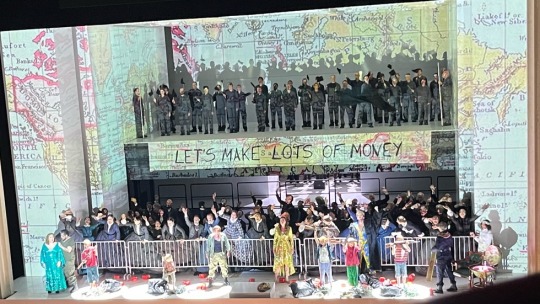
Calixto Bieito you absolute madman. First half utter nonsense, second half sublime. How does it do it.
#opera#opera tag#Calixto Bieito#Giuseppe Verdi#Aida#Nicola Luisotti#Staatsoper unter den Linden#2023
1 note
·
View note
Text
Staatsoper Stuttgart - Jenůfa
Foto ©Martin Sigmund
Dopo il grande successo della ripresa di Katja Kabanova dello scorso febbraio, la Staatsoper Stuttgart ripropone in questi giorni il bell’ allestimento di Jenufa
Continue reading Untitled

View On WordPress
#calixto bieito#canto#critica#elmar gilbertsson#esther dierkes#helene schneiderman#janacek#jenufa#marko letonja#matthias klink#novecento#opera#rosie aldridge#shigeo ishino#staatsoper stuttgart#staatsorchester stuttgart#stuttgart#teatro
0 notes
Text
LICEU 2022/2023: L'INCORONAZIONE DI POPPEA (Fuchs-Kožená-Breiwick-Hansen-Sabata-di Pierro;Bieito-Guglielmi)
L’Incoronazione dI Poppea. Producció de Calixto Bieito. Fotografia de David Ruano gentilesa de Departament de Premsa del Gran Teatre del Liceu
LA PRÈVIA
Si Jordi Savall i Calixto Bieito eren com aigua i oli, pot ser que el mestre igualadí hagués hagut de renunciar a dirigir una magnífica producció amb la qual ell se sentia incòmode. L’aposta era arriscada, d’acord, però també valenta i no crec en…

View On WordPress
#Calixto Bieito#Claudio Monteverdi#David Hansen#Deanna Breiwick#Guillem Batllori#Irene Mas#Jake Arditti#Julie Fuchs#L&039;incoronazione di Poppea#Le Concert des Nations#Luca Guglielmi#Magdalena Kožená#Marcel Beekman#Mark Milhofer#Milan Perišic#Nahuel di Pierro#Natalia Labourdette#Rita Morais#Thobela Ntshanyana#Xavier Sabata
0 notes
Text
Eliogabalo - Oper Zürich 26.12.2022
Eliogabalo - Oper Zürich 26.12.2022 #FrancescoCavalli #CalixtoBieito #DmitrySinkovsky #orchestralascintilla #YuriyMynenko #davidhansen #jameslaing #siobhanstagg #oper #operalover #musicwasmyfirstloveanditwillbemylast
Francesco Cavallis zur Karnevalssaison 1668 entstandene Oper “Eliogabalo” galt lange Zeit als verschollen und wurde erst 1999 wiederentdeckt (UA am Teatro San Domenico in Crema). An der Oper Zürich ist das Werk über den dekadenten römischen Kaiser Elagabalus nun in einer Inszenierung von CALIXTO BIEITO und grossartiger Besetzung zu sehen…
(more…)
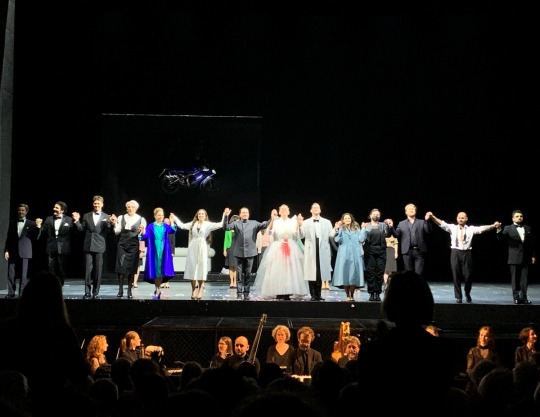
View On WordPress
#Aksel Daveyan#Anna El-Kashem#Benjamin Molonfalean#Beth Taylor#Calixto Bieito#Daniel Giulianini#David Hansen#Dmitry Sinkovsky#Eliogabalo#Entdeckung#Francesco Cavalli#James Laing#Joel Williams#Kritik#Mark Milhofer#Musicwasmyfirstloveanditwillbemylast#Musik#Oper#Oper Zürich#opera#operalover#Orchestra La Scintilla#Rezension#Saveliy Andreev#Siobhan Stagg#Sophie Junker#Yuriy Mynenko
0 notes
Text
opera stream alert

What: Bizet: Carmen, Paris 2017
When: Sunday, January 21, at 19:00 CET (18:00 UCT, 13:00 EST)
Where: Kosmi – https://app.kosmi.io/room/5z1ws1
Who: everyone is welcome!
Extra info: Tumblr's official favorite opera! This particular version, directed by Calixto Bieito, has been touring through Europe's big opera houses for a while now. I will finally watch the recording! It has cars! It has Elina Garanca! There is no hint of bullfighting as far as I can tell. Here's a short trailer on YouTube.
General CW for just about everything, it's Carmen, it's Calixto Bieito, proceed with caution.
19 notes
·
View notes
Text
staatsoper unter den linden afterparty was absolutely wild
after all the speeches and toasting (but free wine!) in the foyer after Calixto Bieito's TERRIBLE staging of Aida (everyone drank all the white wine so there was only red left) the nice Staatsoper press lady brought us into the cantina next door (love a secondary location) and it was the first time I'd seen Germans actually dance to fun music instead of earsplitting techno— the supernumeraries were getting down to 80s pop hits, Jonathan Tetelman rolled up just past midnight wearing sunglasses and hit the dancefloor, and the party was going strong at 1:30 am when we left
#opera#operablr#opera tag#berlin#jonathan tetelman#aida#germany#afterparty#tenor#unter den linden#berlin state opera#staatsoper
2 notes
·
View notes
Text
youtube
Importância do ponto (prompter) em uma ópera
Vídeo com trecho da Ópera Carmen - Viena 2022. Regente: Yves Abel. Produção: Calixto Bieito. Com Elīna Garanča, Piotr Beczała.
Piotr Beczała exita, olha pra prompter, o silêncio segue, e a ouvimos gritar "Eh bien", que é o início da fala dele "Eh bien, damnée". Tudo isto em 1 segundo. Se não fosse a prompter para dar continuidade à cena, talvez a Carmen estivesse viva até hoje. :-)
“Ponto” (prompter) é o profissional do teatro responsável por “sussurrar” as falas que devem ser repetidas, em voz alta, pelos atores quando eles esquecem. O prompter é invisível para o público, e pode ser apenas uma pessoa entre os cerca de 250 membros da equipe, mas desempenha um papel importante para evitar que tudo descarrile. Dentro do seu cubículo abafado à beira do palco, é tudo muito simples. Há um suporte de madeira para guardar a partitura, monitores para ver o maestro, uma ventoinha para lidar com o calor, um telefone para ligar para a direção de cena, no caso de o áudio ou o vídeo falharem, e um pequeno teclado eletrônico, convenientemente preso com velcro à lateral da caixa, para ajudar o prompter a indicar o pitch correto – embora raramente seja necessário, uma vez que a maioria das pessoas que fazem este trabalho tem um ouvido e sentido de afinação perfeitos.
O Mundo Secreto do Ponto na Ópera
youtube
0 notes
Text
Zoltan Nagy started his international career as the youngest ensemble member of the Vienna State Opera. Recognized by opera critics for his strengths in both dramatic and comic roles, he is regularly invited to perform as a guest artist in many of Europe’s leading opera houses. Zoltan’s most requested role is Escamillo (Carmen), a role he has performed in over 12 productions in theatres like Bilbao (ABAO), Teatro Massimo di Palermo, Teatro Grande di Brescia, Teatro Ponchielli di Cremona, Teatro Sociale di Como, RTE Orchestra in Dublin, Romanian National Opera Bucharest and Cluj, the Shaanxi Grand Opera House in China, the State Theatre of Nuremberg, among others. As a permanent guest soloist of the Hungarian State Opera, Budapest, Zoltan has been invited to perform the role of Guglielmo (Cosi Fan Tutte), Silvio (Pagliacci), the title role in Kodaly’s Hary Janos, and Schaunard (La Bohème), a title he has performed at Oper Leipzig, Opera de Nice, Singapore Symphony Orchestra (in concert), Vlaamse Opera Antwerpen, and Opera Ghent among others. Zoltan made his Bolshoi Theatre of Moscow debut with the role of Count Almaviva (Le Nozze di Figaro). He has sung Haraschta (The Cunning Little Vixen) at the Hamburg State Opera, Dr Falke (Die Fledermaus) at Teatro Verdi Trieste, Calchas (Iphigenie en Aulide) in Athens, Schmied (Egk’s Peer Gynt) in Theater an der Wien, where he also had the privilege to join Edita Gruberova for her gala concert. Zoltan made his debut as Alberich (Siegfried) at Teatro Campoamor in Oviedo. He sang Marcello in a new production of La Bohème at Teatro Comunale di Sassari, portrayed the role of Dulcamara in a new production of L’Elisir d’Amore at the Romanian National Opera, and was invited to give masterclasses at the Xi’an University of Music in China. Count Tomski was a role debut in a new production of Tchaikovsy’s Pique Dame at the Opera Festival Heidenheim accompanied by the Stuttgarter Philharmoniker. Zoltán returned to Oviedo for a new production of Götterdämmerung where he performed the role of Alberich. He sings the role of Theseus in the Essen Philharmonic’s CD live recording of Bohuslav Martinu’s Ariane directed by Czech conductor Tomas Netopil, released in 2016 on Supraphon.
Zoltan has worked with conductors such as Marco Armiliato, Pinchas Steinberg, Ulf Schirmer, Renato Palumbo, Fabio Luisi, Marc Minkowski, John Wilson, Alejo Perez, Tomas Netopil, Guillermo Garcia Calvo, Leo Hussain, Marcus Bosch among others. Some of the stage directors Zoltan has collaborated with are: Peter Konwitschny, Damiano Michieletto, Inga Levant, Stefano Poda, Calixto Bieito, Paris Mexis, Thorsten Fischer, Georges Delnon, Maurizio Scaparro, and Immo Karaman. He has collaborated with the Vienna Philharmonic, Robert Schumann Philharmonie, RSO Vienna, Vienna Symphony Orchestra Singapore Symphony Orchestra, National Taiwan Symphony Orchestra, Orchestra of the Romanian National Radio, Hungarian National Philharmonic Orchestra among others. Zoltan studied at the Gheorghe Dima Music Academy in his hometown Cluj-Napoca under Professor Gheorghe Roşu. Upon graduation, he received a full scholarship to study at the prestigious Mozarteum University in Salzburg for a Masters degree in voice performance with Professor Boris Bakow. He has won prizes at various singing competitions including the Romanian National Song Competition, the Hariclea Darclee International Voice Competition, and “Debut”, the European Opera Singing Competition in Germany. In 2012 Zoltan participated in the Salzburg Festival’s Young Singers Project, and was then selected to sing in the Festival’s production of Das Labyrinth. Recent engagements included two new production of La Wally and Jenufa at Theater an der Wien, a new production of The Raise and Fall of the city of Mahagonny in Parma. Future higlights of his saison include a debut at Regio Torino as Escamillo, a ROH debut in La Bohème as Schaunard and a debut at Komische Oper Berlin in the Love of the three oranges as Leander.
Dear Zoltan, I’m so glad to meet you, this time in Italy! And I am very much looking for- ward to your house debut at Teatro Regio di Parma! What has been your relationship with the Italian theatres throughout your career and what does this event mean to you?
In my nearly 15 years of international career I have been lucky enough to be part of some wonder- ful productions all over the world starting with Vienna until Singapore, but singing ocasionally in Italy, becomes each time on of the highlights of my season. My first ever concert accompanied by an orchestra abroad was actually in Palermo when I was 22. Since then I was dreaming about singing one day at Teatro Massimo which was closed for renovation those years. Several years later my dream came true and I was indeed portraying the role of Escamillo in that amazing opera house… I always used to say, that a part of my heart is in Italy. I’ve also worked on several occa- sions at Teatro Verdi in Trieste, one of them was a very funny production of Die Fledermaus (Dr. Falke) with the late Gianluigi Gelmetti conducting who I was very fond of. I have beautiful memo- ries of Sardegna where I’ve done a new production of La Bohème as Marcello, and later a Pagliacci as Silvio. Singing at Teatro Regio in Parma is an absolut honor for me not only because of the enormous tradition that surrounds this opera house but also because of the fact that I am a guest artist in a very unusual production that should make history in Parma.
Tell us more about this opera, about the role that you’re about to perform and the produc- tion that will be on stage at Regio di Parma this month (April)?
Rise and Fall of the City of Mahagonny is an opera, although I like to call it rather music theater/ music play… composed between 1927-1929 by Kurt Weill on Bertold Brecht’s libretto, where I will interpret the role of Trinity Moses. When I first saw the score, I said to myself… “oh, I’ll deifinitely need some time to learn this music and get used to certain rhytms“. I’ve seen it challenging but I ended up having great fun singing this part and enjoying Weill’s geniality. The opera was a scandal on its premierere in Leipzig in 1930, presenting the decandece of the society which is more then actual nowadays where money is everything. I hope the audience will be receptive, of course, one should not expect a coservative staging for this type of music. I’m sure everyone will leave the the- ater whistling the Alabama song at the end of the performance… and realizing hopefully how en- joyable this music is.
reposted from https://opera-charm.com/
0 notes
Text
Deborah Warner, Calixto Bieito y Costanzo, condecorados en la II edición de los Premios Teatro Real
MADRID, 29 May. (EUROPA PRESS) –
Los directores de escena Deborah Warner y Calixto Bieto y el contratenor Anthony Roth Costanzo han sido condecorados este lunes en la II gala de los premios de este teatro que ha sido presentada por Anne Igartiburu.
En la presente edición los premios institucionales han sido concedidos a Ivor Bolton, director musical del Teatro Real; Andrés Máspero, director del…
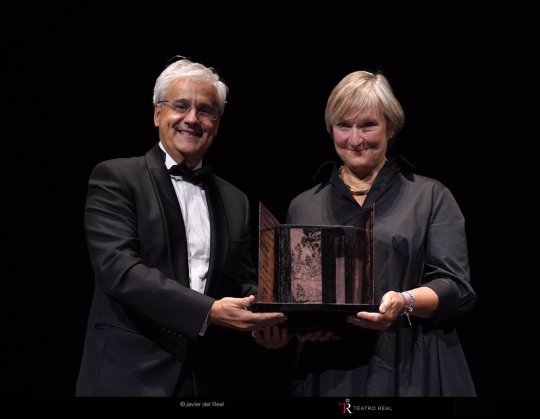
View On WordPress
#armonio acordeón#arpa#banjo#bombardino#bombo#caja china#caja clara#campanas tubulares#carrillón#cascabeles#castañuelas#celesta#cítara#clarinete#clarinete bajo#clavecín#claves#clavicordio#contrabajo#contrafagot#corneta#corno inglés#crótalos#fagot#flauta#flautín#fliscorno#glockenspiel#gong#güiro
0 notes
Text
Tu es le diable! / Az ördög maga vagy!/
Bizet: Carmen / Opera
D. Magyari Imre |
Ha egy magányos telefonfülke áll egy tér és a tizenkilencedik század közepén, az óhatatlanul jelent valamit. Leginkább azt, hogy nem is a tizenkilencedik század közepén vagyunk. És valóban nem: olvasom az opera.hu-n, hogy a katalán rendező, Calixto Bieito, aki egyébként „az operarendezés Tarantinója” (míg ellenben Tarantino bizonyára a filmrendezés…

View On WordPress
0 notes
Text
Először Magyarországon Tolsztoj nagyszabású regényének operaváltozata
Először Magyarországon Tolsztoj nagyszabású regényének operaváltozata
Prokofjev Háború & béke című operáját a világhírű katalán operarendező, Calixto Bieito színrevitelében, Brassói-Jőrös Andrea, Brickner Szabolcs és Szegedi Csaba főszereplésével, összesen 28 énekes szólista közreműködésével mutatja be 2023. január 28-án a Magyar Állami Operaház. Az előadásban, amely a Genfi Nagyszínházzal koprodukcióban jött létre és február 18-ig hét alkalommal tekinthető meg az…
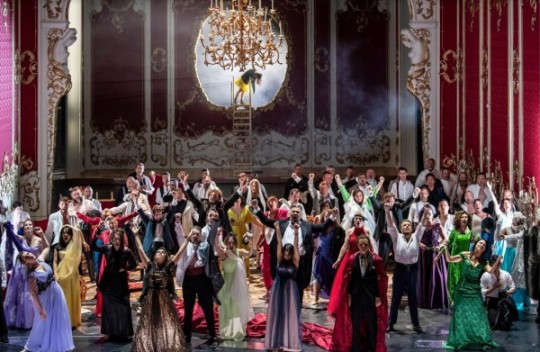
View On WordPress
0 notes
Text
reading about the production of Bernarda Alba i watched and loved yesterday and his director Calixto Bieito and turns out he did Macbeth back in 2001 which is the other book i borrowed from the library and isn't that a nice coincidence <3
#but also he likes to approach classics with a new perspective a twist and some risk and i feel like im doing this all backwards#like. how do I fully appreciate the renewal if I'm not well versed in the tradition first. fuck
1 note
·
View note
Text

In honour of tonight’s Lohengrin premiere
10 notes
·
View notes
Text
Guerre et paix - Grand Théâtre de Genève 19.09.2021
Guerre et paix - Grand Théâtre de Genève 19.09.2021 #SergejProkofiev #Oper #Rezension #CalixtoBieito #Genf #Musik #KriegundFrieden #LeoTolstoi #Napoleon #Russland #Kritik #Besprechung
Das Grand Théâtre de Genève eröffnete die neue Saison mit einer spektakulären Inszenierung von Prokofievs Oper “Krieg und Frieden”, ein – der literarischen Vorlage entsprechend – grosses Mammutwerk – keine leichte Muse, aber der Besuch lohnt sich unbedingt, nicht nur wegen der wunderbaren Musik…
Continue reading
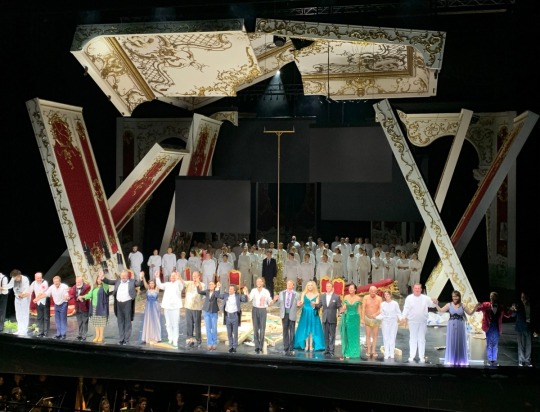
View On WordPress
#Alan Woodbridge#Alejo Pérez#Ales Briscein#Björn Bürger#Calixto Bieito#Elena Maximova#Genf#Grand Théâtre de Genève#Guerre et Paix#Krieg und Frieden#Leo Tolstoi#Oper#operalover#Orchestre de la Suisse Romande#Rebecca Ringst#Ruzan Mantashyan#Sarah Derendinger#Sergej Prokofjew
0 notes
Text
Review - Lohengrin
Staatsoper unter den Linden Berlin
Director: Calixto Bieito
Conductor: Matthias Pintscher
That production was a ride from start to finish. There was an interesting cast, Roberto Alagna finally making his Lohengrin Debut and René Pape who’s been King Heinrich since before I was born.
But let’s start at the very beginning. This Lohengrin features a picture of a woman pregnant with a swan, a topic that won’t be adressed any further. A swan appears only on projections, on stage only ever as a little paper swan Roberto Alagna holds.
That’s a great sign of how traditional Bieito’s staging is: Not at all. In all three acts he features his favourite device, a cage. While it makes sense to put Elsa there in the first act, by the way: She enters the cage herself and exits it herself, she does not need Lohengrin to free her, it’s most effectively used in act three: After everything has gone to shreds, Elsa has popped the question, Lohengrin is about to start his tail, René Pape who has previously also been down on the floor, not in full-on Kaufmann-Style, but because he’s powerless, enters the cage and watches the pure chaos emerge. While I was confused at first, this decision is now one of my favourite elements of the staging. It beats the herald putting on Joker-Makeup at the end of the first act and the rest of the chorus following him by act two, as well as Lohengrin removing his shirt after In fernem Land by a lot.
I also liked Elsa sitting under her huge veil when Ortrud comes to “apologize” to her, It showed her dreaming of the wedding, but also being captured, as that veil is really big. Later Ortrud was under that veil.
Something I’m unsure about is the wedding in the end of act two. Elsa wears a beautiful, fairytail wedding dress and previously mentioned veil, which fits her character as she really wants to marry Lohengrin. Having her strip down the wedding gown when Ortrud confronts her and putting it back on after Lohengrin’s appearance also made sense - Elsa looses all hope to get her wedding and her knight, said knight saves her. But why is everybody eating? Elsa’s bridemaids have food hidden in their bouquets, Elsa sneaks off to have cake. I didn’t quite catch the reasoning behind that. I know why the cake is there, it features two lovely figurines - a couple - which Ortrud destroys after realising she failed.
That’s as much as I will say about the staging, there are a lot more details but I believe this is all you need to know. I said before that the cast is intresting, we have two role debuts and a king, and that’s what I want to talk about now.
René Pape did not disappoint. He didn’t play the fatherly King Heinrich as he does in other productions, he played King Heinrich as if he was the boss of a company, listening to the people around him but in the end holding the power. His fantastic voice played a big role on the power part. In act three you could watch him lose his power which I personally found very capturing.
Less capturing but still good were Ekaterina Gubenova as Ortrud and Martin Gantner as Telramund. The latter started extremly good in act one, with a voice that sounds like an operatic speaking voice - everything you expect from an opera singer is there but I can imagine his voice sounding exactly like that when he speaks. Every word he says can be understood well and I’d call him one of my favourite’s in this production if he hadn’t become so incredibly boring by act two.
Voice-wise this Elsa, Vida Mikneviciute, could easily become my favourite: Her voice is sweet, yet dramatic, her vibrato is strong but not overshadowing, especially in the first act she had a very clear phrasing. Her voice is everything I expect from an Elsa, youthful and wagnerian at the same time. Her acting fits the production, Elsa is strong and plays with her looks, however, and that out me off in this production, I prefer my Elsas playing less the most beautiful woman in Brabant and more the young dreamy girl he is. Allthough Ortrud was powerful in this production, Telramund and the other men where mostly driven by the fact that this beauty didn’t want to marry one of them. I’m very curious to see Mikneviciute in another staging.
Now, I suppose most people, including me, watched this production to see Roberto Alagna’s Lohengrin debut. Previously I heard him sing one phrase which I loved, that is why I started this production with high expectations in him. Unfortunately I was disappointed: While Alagna definitely brought emotion to his Lohengrin, he couldn’t quite reach other performers like Jonas Kaufmann who plays Lohengrin on a very emotional level.
His singing was incredibly unsatisfying as well: Alagna’s voice had another colour with almost every note he sang, which made him sometimes sound as if he rather sang incoherent words instead of Wagner’s weird but very coherent phrases. I also believe I noticed some intonation struggles. I know Lohengrin very well so I notice when a note isn’t quite right and I admit that especially in act one I was sometimes a little irritated. I hope that Alagna will grow into the role, if not - well, considering how he broke his contract with the Bayreuth Festival in 2018, I don’t need him as a Wagner Singer.
Trying to end this review on a positive not, Matthias Pintscher’s conducting was surprisingly conventional and definitely a pleasure to listen to.
I recommend this Lohengrin for when you’re curious for a new production, if you just want to lay back and enjoy an opera, this production, even though it’s rather good, is not for you.
#lohengrin#review#opera review#wagner#wagner opera#richard wagner#not tagging singers especially not the one I'm mean to
6 notes
·
View notes
Text

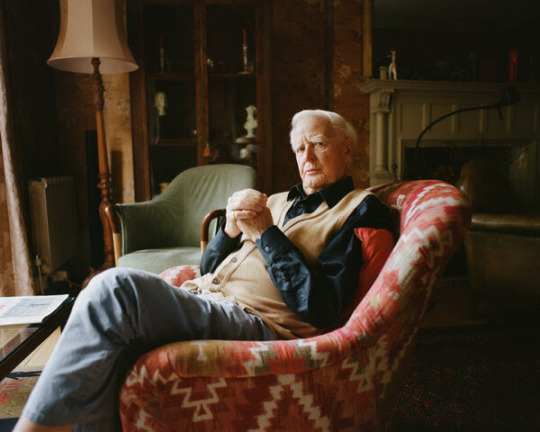

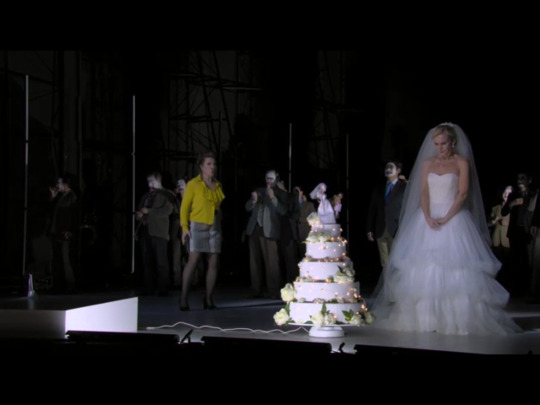

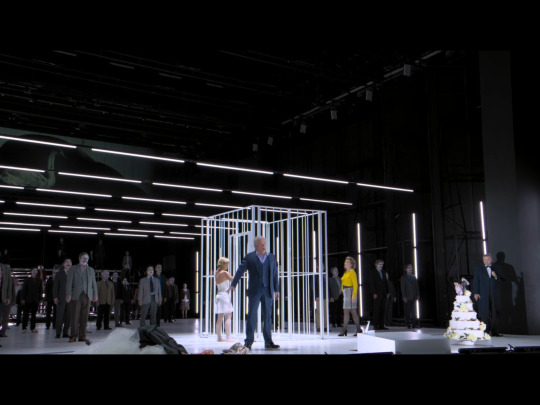


POSTAL DE COLARES A 13 DE DEZEMBRO - A PESADA AMEAÇA DO SARS-COV2, MORTE DE JOHN LE CARRÉ E O LOHENGRIN DA STAATSOPER: Portugal teve nas últimas 24 horas, 98 mortes ( novo recorde ) e 4044 novos casos. De acordo com o boletim da Direção-Geral da Saúde, há a registar um aumento dos doentes internados , mais 64, num total de 3157. Há também mais doentes nas Unidades de Cuidados Intensivos (513 ), mais 10 do que ontem. A Região Norte é a que regista o maior numero de novos casos (2143) . Entretanto uma Euro sondagem de sábado mostra que mais de um terço dos portugueses não mostra interesse em receber a vacina do COVID-19 por não acreditarem na sua eficácia. O Dr Fauci já declarou ser este o seu maior receio em relação a eficácia do plano de vacinação nos EUA. A pandemia continua a galope ...
Outra noticia do dia foi a morte do famoso escritor John le Carré antigo espião do M 15 .Alguém disse sobre a sua obra : “, o verdadeiro tema de le Carré não é a espionagem. É o labirinto infinitamente enganador das relações humanas. ” Por isso os seus heróis não são espectaculares como o personagem James Bond de Ian Fleming . John Smiley é um europeu triste ...
Tambem foi domingo de “ opéra em casa “ e um deleite para este wagneriano com o streaming no canal ArteTv. do Lohengrin da Staatsoper Unter den Linden em Berlim .A grande novidade desta produção era a a estreia no papel do tenor Roberto Alagna desde que “fugiu” da produção da ópera no Festival de Bayreuth em 2019 .Roberto Alagna teve um desempenho aplicado mas enfrentou problemas de sotaque no alemão e esforço para alcançar toda a extensão do canto wagneriano , principalmente nos agudos. Mas por outro lado o tenor traz um timbre condizente com o Cavaleiro do Cisne lembrando porque o Lohengrin é considerada a mais italiana das óperas de Wagner..A soprano Vida Miknevičiūtė (substituindo Sonya Yoncheva) também fez sua estreia no papel de Elsa e não me impressionou .René Pape encarna o Rei da Germânia (Henri l'Oiseleur), com nobreza e a enorme qualidade vocal que ainda possui A excelente mezzo Ekaterina Gubanova, (que já ouvimos na Gulbenkian ) personificou bem Ortrud.Na sua estreia na Staatsoper Unter den Linden em Berlim, o mal amado Calixto Bieito (cuja Tetralogia em Paris foi cancelada este ano grande pena minha pois tinha comprado bilhetes em 2019 ...) teve as grandes condicionantes da pandemia para a movimentação dos personagens e para a utilização dos coros peça central nesta opera .No palco essencialmente uma gaiola dupla , os cantores são prisioneiros de posições fixas, movendo-se muito pouco. A sequência de cenas mostra alguns despindo-se , outros esfregando as mãos e o torso com sangue, outros fazendo maquiagem de palhaço ou comendo um boletim de voto brandido pelo rei. Uma imagem de marca será Elsa depois de se desembaraçar do véu de noiva devorar em êxtase o bolo nupcial. ..No final, todos veem sua expressão reduzida a slogans brandidos em folhas de papel: "coragem", "esperança", "felicidade" ou o símbolo da paz e do amor. Uma imagem (como tantas outras) resume a dimensão literal desta pintura: Elsa e Lohengrin puxando e segurando as mangas do casaco do herói, onde Liebe (amor) está escrito. INFERIOR AO LOHENGRIN A QUE TIVEMOS A FELICIDADE DE ASSISTIR EM BAYREUTH AGOSTO DE 2019 com BECZALA E HARTEROS EMBORA TAMBÉM COM UMA ENCENAÇÃO CRITICAVEL
1 note
·
View note